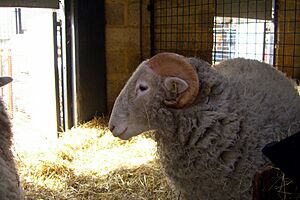Whitefaced Woodland facts for kids
The Whitefaced Woodland is a special type of sheep that comes from the Woodlands of Hope, a hilly area in England's South Pennines. This breed was created by mixing two older sheep types: the Woodland sheep and the Penistone sheep. The Penistone sheep got its name from a town in Yorkshire where sheep have been sold for a very long time, since 1699!
The Whitefaced Woodland sheep is thought to be related to other sheep breeds like the Swaledale and the Lonk. Even though many of these sheep live in their home region, the breed is considered "vulnerable" by the Rare Breeds Survival Trust. This means there are fewer than 900 female sheep of this breed in Great Britain that can have babies.
What Makes Whitefaced Woodland Sheep Special?
The Whitefaced Woodland is one of the biggest sheep breeds that lives in hilly areas. Female sheep, called ewes, can sometimes weigh more than 60 kilograms (about 132 pounds) when they live in flatter, lowland fields.
Appearance and Wool
Unlike many other sheep from the Pennine hills, the Whitefaced Woodland sheep has a white face and white legs. Its wool is short and fine. The wool fibers are usually between 10 cm (about 4.7 inches) and 15 cm (about 7.1 inches) long. Each sheep's fleece (all its wool) weighs about 2 kg (4.5 pounds) to 3 kg (6.5 pounds).
Horns and Uses
Both male (rams) and female (ewes) Whitefaced Woodland sheep have horns. The ram's horns are very big and spiral in shape. These sheep have mostly been raised for their meat. However, their wool is also used to make things like carpets.


